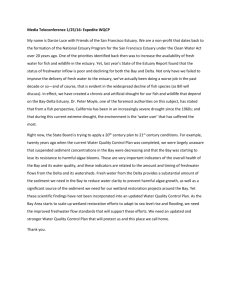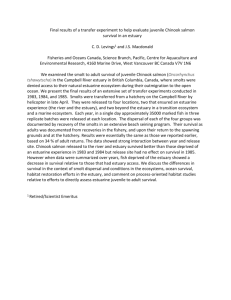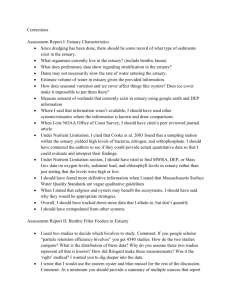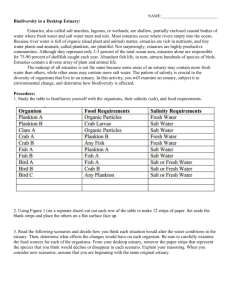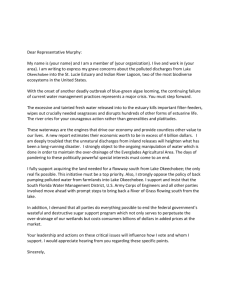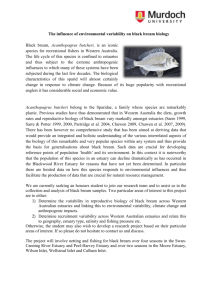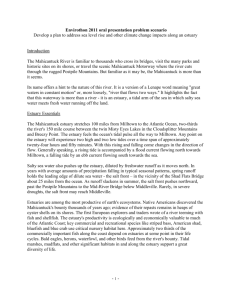- The Deben Estuary Plan
advertisement
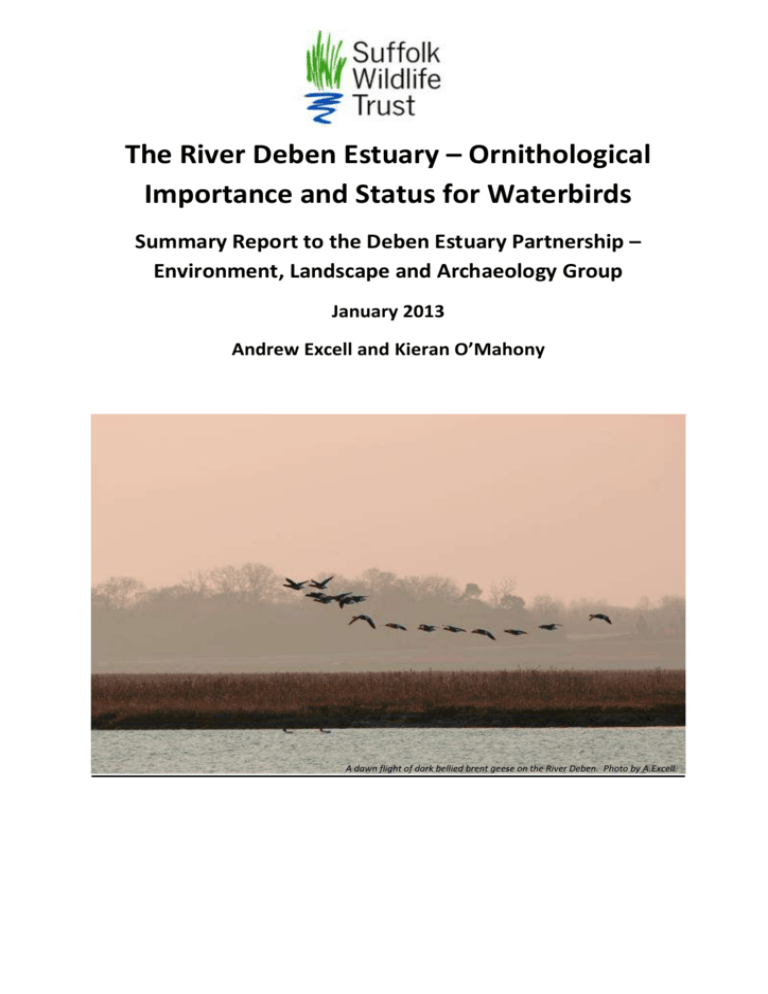
The River Deben Estuary – Ornithological Importance and Status for Waterbirds Summary Report to the Deben Estuary Partnership – Environment, Landscape and Archaeology Group January 2013 Andrew Excell and Kieran O’Mahony A dawn flight of dark bellied brent geese on the River Deben. Photo by A.Excell Contents 1. Background to Waterbird Importance 2. Designations for the River Deben 3. Current Population Status and Species of Note 4. Species Summary and Discussion - Maps and Key Species Shown - Waterbirds of the River Deben – Summary Tables i International Importance ii National Importance iii Other Species Noted in Significant Numbers 5. Appendices - Appendix 1 – References - Appendix 2 – Birds of Conservation Concern (BoCC) - Appendix 3 – Disturbance to Waterbirds – facts from research - Appendix 4 – Key to BTO Species Codes Background to Waterbird Importance Any site recognised as being of international ornithological importance is considered for classification as a SPA under the EC Directives on the Conservation of Wild Birds (EC/79/409), whilst a site recognised as an internationally important wetland qualifies for designation as a Ramsar site under the Convention on Wetlands of International Importance especially as Waterfowl Habitat. Under criterion 6, a wetland is considered internationally important if it regularly holds at least 1% of the individuals in a population of one species or subspecies of waterbird, while criterion 5 states that any site regularly supporting 20,000 or more waterbirds also qualifies. A wetland in Britain is considered nationally important if it regularly holds 1% or more of the estimated British population of one species or subspecies of waterbird. Designations for the River Deben The River Deben was designated as a Special Protection Area (SPA) for its wintering avocet numbers (for having 95 wintering individuals representing at least 7.5% of the national wintering population at the time - the 5 year mean peak between 1991/2 and 1995/6). From September 2012 this designation has been revised to include dark bellied brent goose as well. The estuary was also designated as Site of Special Scientific Interest (SSSI) in February 1991 under Section 29 of the Wildlife and Countryside Act 1981. As part of the designation, several bird species were selected as being of national or international importance. The following extract is taken from the designation at that time. “The numbers of redshank overwintering on the Estuary are of international importance and the summer breeding population of this species is of county significance. The site is of national importance for its winter populations of dark-bellied brent goose, shelduck and black tailed godwit with the numbers of wigeon, pintail and grey plover approaching this level in some years. The Estuary supports many other species including high numbers of dunlin, curlew and mute swan.” The estuary also has Ramsar site status since 1996, qualifying under Criterion 3c by “regularly supporting internationally important wintering numbers of dark-bellied brent geese. Notable also are nationally important numbers of the following migratory waterfowl, shelduck, avocet, grey plover, black tailed godwit, and redshank”. Avocet roosting on the Deben Estuary mudflats. Photo by A.Excell Current Population Status and Species of Note There have been some inevitable population shifts on the estuary since these designations were established, partially reflecting international population levels and migratory patterns. However, the estuary clearly still supports internationally and nationally important numbers of bird species, as data from the ongoing national Wetland Bird Survey data (WeBS) testifies. An annual total of around 20,000 waterbirds are present in the estuary. Species accounts are given below for those birds that should be taken into account for revision of the SPA and SSSI features in particular. Species Summary and Discussion The species in the following tables are present on the Deben Estuary in either internationally or nationally important numbers (taken from the last 10 years of WeBS reports). The status of each species is also given as red, amber or green, classified as a Bird of Conservation Concern (BoCC). For classification criteria on BoCC birds, please see Appendix 2. The importance of the full length of the estuary for these bird species, including the mudflats, saltmarsh, creeks, its hinterland and adjoining freshwater grazing marsh habitats cannot be overstated. Dunlin feeding on the Deben Estuary mudflats – photo by A.Excell In addition to the main feeding areas on the estuary (particularly the total estuary length of mudflat and saltmarsh habitat), the key high tide roosting areas are of great significance, as it is at these times and locations where disturbance to the birds is most likely. Disturbance at any time of year can be considered significant, and most damaging to bird ecology in winter months when the birds are requiring completely uninterrupted roost sites to conserve body heat and energy levels. For further information and research-based examples of disturbance setback distances, please see Appendix 3. Roosting waders and waterfowl at high water on the Deben Estuary – photo by A.Excell Waterbirds breeding on the estuary clearly also require safe, uninterrupted areas for success. As several of these species tend to favour habitat within the estuary hinterland for breeding, locations have not been shown on the maps, as land use changes can be more frequent. Encouraging a greater number of landowners to enter into agri-environment schemes within the estuary catchment is of great importance in the short term future. Maps and Key Species Shown The bird maps developed as part of the Deben Estuary Partnership have flagged up feeding zones and several significant roost areas, identified from many years of monthly WeBS surveys and additional survey work conducted from boat. Particular attention should be paid to levels of current and proposed recreational activity in the vicinity of these areas, especially those areas noted as significant roosts. Without these refuges, the estuary could quickly lose much of its avifauna. Although these focal roost sites shown on the maps are of great significance, it is extremely important to note that a number of waterbird species also use the base of river wall sections to roost, and that these highly linear roost sites stretch along much of the estuary length. These linear roosting areas have not been shown on the maps, to aid clarity. Key bird species in each roost area have been allocated their relevant BTO name codes. These can be seen in the tables within this report, and in Appendix 4. Maps have been split into sections (shown on 7 maps). These include visual divisions for the 5 DEP estuary sections, from section 1 at the mouth of the estuary at Felixstowe Ferry and Bawdsey, to section 5, upstream of Wilford Bridge, Melton. Unfortunately, reproduction of maps in 5 sections mirroring those developed by DEP proved difficult as those sections are of widely varying lengths. Too much detail would also have been lost from the maps in this report. It is worth noting that many other birds have a strong association with the estuary, including iconic species such as barn owl, short eared owl, nightingale, common tern, little tern, twite, snow bunting, skylark and meadow pipit. None of these species have been shown on the maps, as they either have stronger associations with the hinterland zones of the estuary, or are otherwise not linked so completely with large roosting groups and risk of disturbance at similar levels. The information contained within this brief summary report must be considered as ‘work in progress’, and hopefully it will help inform the review process of the estuary’s protected status. Contributions from other groups will be welcomed. The importance of collecting and analysing ongoing field data is paramount to the success of protecting the estuary’s biodiversity. Waterbirds of the River Deben International Importance Species Black tailed godwit (BW) BoCC Status Red Mean nos of birds on estuary between 2000/1 and 2004/5 248 Mean nos of birds on estuary between 2006/7 and 2010/11 680 Mean nos of birds on estuary between 2000/1 and 2004/5 241 1915 Mean nos of birds on estuary between 2006/7 and 2010/11 299 1463 Qualifying international threshold 610 National Importance Species Avocet (Av) Dark bellied brent goose(DB or BG) Grey plover (GV) Little egret (ET) Redshank (RK) Shelduck (SU) BoCC Status Amber Amber Amber Amber Amber Amber 537 n/a 2095 799 485 49 2140 649 Qualifying UK threshold 75 910 430 45 1200 610 Other Species Noted in Significant Numbers Note that some of the species shown have peak counts close to, or in excess of the qualifying UK threshold. Species Bar tailed godwit (BA) BoCC Status Amber Mean nos of birds on estuary between Jan 2010 and Dec 2012 41 Max nos of birds on estuary between Jan 2010 and Dec 2012 102 (Feb 2012) Qualifying UK threshold 380 Curlew (CU) Dunlin (DN) Golden plover (GP) Knot (KN) Lapwing (L.) Little grebe (LG) Pintail (PT) Amber Red Amber Amber Red Amber Amber 768 2919 n/a 130 2681 68 102 1032 (Oct 2011) 3670 (Dec 2011) 3813 (6449 in 2010/11) 223 (Jan 2012) 4478 (Jan 2011) 102 (Feb 2012) 176 (Jan 2011) 1400 3500 4000 3200 6200 160 290 Worthy of additional note here are dunlin and lapwing, both red listed birds in serious decline. The Deben estuary supports occasional peak numbers of dunlin in excess of the UK qualifying threshold, and this species feeds and roosts along the entire estuary length. Lapwing numbers, although below UK threshold levels, are clearly significant, and would have the potential to be much higher with additional appropriate agricultural hinterland management. Golden plover numbers have recently exceeded the UK qualifying threshold, and this species may well be listed as nationally important in years to come. Species such as knot, little grebe and pintail have been listed above as they each tend to be concentrated in one section of the estuary only, and could be easily displaced from the estuary by increased recreational pressure. A typical assemblage of waterfowl on the River Deben at ‘The Tips’ – photo by A.Excell Appendices Appendix 1 References Banks, A. , Collier, M. et al (2006) Waterbirds in the UK 2004/5 – The Wetland Bird Survey. Published by BTO, WWT, RSPB & JNCC Holt,C. , Austin, G et al (2012) Waterbirds in the UK 2010/11 – The Wetland Bird Survey. Published by BTO, RSPB, JNCC in association with WWT JNCC (2001) SPA Description – Deben Estuary. – jncc.defra.gov.uk/default.aspx?page=2023 (28.01.2013) JNCC (2008) Info Sheet on Ramsar Wetlands – River Deben. -jncc.defra.gov.uk/pdf/RIS/UK11017.pdf Mason, N. et al (2010-20120 Deben Estuary WeBS raw data for all nine estuary sectors Jan 2010-Dec 2012. Unpublished data for WeBS UK reports. Appendix 2 Conservation Status of Birds in the UK – and Birds of Conservation Concern (BoCC) The conservation of birds in the UK involves a partnership of governmental and non-governmental organisations, including the Joint Nature Conservation Committee (JNCC), Natural England, the Royal Society for the Protection of Birds (RSPB), the British Trust for Ornithology (BTO) and the Wildlife Trusts. In 2002, the leading conservation organisations reviewed the population status of the birds that are regularly found here and placed each onto one of three lists – red, amber or green. This categorisation gives an indication of the relative priority that should be given to each species, and the lists will help to guide future conservation efforts in the UK. Red list species are those that are globally threatened, whose population or range has declined rapidly in recent years (i.e. by more than 50% in 25 years), or which have declined historically and not recovered. Amber list species are those whose population or range has declined moderately in recent years (by more than 25% but less than 50% in 25 years), those whose population has declined historically but recovered recently, rare breeders (fewer than 300 pairs), those with internationally important populations in the UK, those with localised populations, and those with an unfavourable conservation status in Europe. Green list species are those remaining species that fulfil none of the criteria. The review excluded species that are not native to the UK and those that occur irregularly as vagrants or scarce migrants. Appendix 3 Disturbance to Waterbirds – The facts from Research 2012 Information kindly supplied by Natural England Examples of set-back distances 180m as the ‘safe’ distance for approach for pedestrians and boats for tern colonies, based on work in Florida (Rodgers & Smith 1995) 70m as a recommended distance to protect roosting cormorants, gulls and oystercatchers from disturbance from kayaks and motorboats off Vancouver Island (Chatwin 2010) 200m as the necessary zoning required to protect common tern colonies from disturbance (people on foot) at colonies in Virginia and New Carolina (Erwin 1989) 100m as the necessary zoning required to protect least (very similar to little) and royal tern colonies from disturbance (people on foot) at colonies in Virginia and New Carolina (Erwin 1989) 100m as the necessary distance to protect nesting common terns from disturbance effects of personal watercraft in New Jersey (Burger 1998) 200m as the approximate distance at which curlews roosting on saltmarsh in Holland could be approached before taking flight (Smit & Visser 1993) 25-550m as the distance at which different wader species and brent geese were recorded taking flight when approached by someone walking across mudflats at two different sites in Holland (Smit & Visser 1993) 5-178m (median 52m) as the distance at which brent geese responded to a potential disturbance event on the Solent. Data from 20 locations (Liley, Stillman, & Fearnley 2010). 10-200m (median 46m) as the distance at which oystercatchers responded to a potential disturbance event on the Solent. Data from 20 locations (Liley et al. 2010). 75-150 (median 44.5m) as the distance at which redshanks responded to a potential disturbance event on the Solent. Data from 20 locations (Liley et al. 2010). 25-200m (median 75m) as the distance at which curlews responded to a potential disturbance event on the Solent. Data from 20 locations (Liley et al. 2010) The figures above are taken from the following research papers Burger, J. (1998) Effects of Motorboats and Personal Watercraft on Flight Behaviour over a Colony of Common Terns. Condor, 100, 528-534. Chatwin, T. (2010) Set-back distances to protect nesting and roosting seabirds off Vancouver Island from boat disturbance, http://dspace.royalroads.ca/docs/handle/10170/375 Erwin, R.M. (1989) Responses to Human Intruders by Birds Nesting in Colonies: Experimental Results and Management Guidelines. Colonial Waterbirds, 12, 104-108. Liley, D., Stillman, R.A. & Fearnley, H. (2010) The Solent Disturbance and Mitigation Project Phase II. Results of Bird Disturbance Fieldwork, 2009/10. Footprint Ecology / Solent Forum. Rodgers, J.A. & Smith, H.T. (1995) Set-Back Distances to Protect Nesting Bird Colonies From Human Disturbance In Florida. Conservation Biology, 9, 89-99. Smit, C.J. & Visser, G.J.M. (1993) Effects of Disturbance on Shorebirds: a Summary of Existing Knowledge from the Dutch Wadden Sea and Delta Area. Wader Study Group Bulletin, 68, 6-19. Appendix 4 Key to BTO Species Codes AC Arctic Skua AE Arctic Tern AV Avocet BO Barn Owl BY Barnacle Goose BA Bar-tailed Godwit BR Bearded Tit BS Berwick's Swan BI Bittern BK Black Grouse TY Black Guillemot BX Black Redstart BJ Black Tern B. Blackbird BC Blackcap BH Black-headed Gull BN Black-necked Grebe BW Black-tailed Godwit BV Black-throated Diver BT Blue Tit BU Bluethroat BL Brambling BG Brent Goose BF Bullfinch BZ Buzzard CG Canada Goose CP Capercaillie C. Carrion Crow CW Cetti's Warbler CH Chaffinch CC Chiffchaff CF Chough CL Cirl Bunting CT Coal Tit CD Collared Dove CM Common Gull CS Common Sandpiper CX Common Scoter CN Common Tern CO Coot CA Cormorant CB Corn Bunting CE Corncrake CI Crested Tit CR Crossbill (Common) CK Cuckoo CU Curlew DW Dartford Warbler DI Dipper DO Dotterel DN Dunlin D. Dunnock EG Egyptian Goose E. Eider FP Feral Pigeon ZL Feral/hybrid goose ZF Feral/hybrid mallard type FF Fieldfare FC Firecrest F. Fulmar GA Gadwall GX Gannet GW Garden Warbler GY Garganey GC Goldcrest EA Golden Eagle OL Golden Oriole GF Golden Pheasant GP Golden Plover GN Goldeneye GO Goldfinch GD Goosander GI Goshawk GH Grasshopper Warbler GB Great Black-backed Gull GG Great Crested Grebe ND Great Northern Diver NX Great Skua GS Great Spotted Woodpecker GT Great Tit GE Green Sandpiper G. Green Woodpecker GR Greenfinch GK Greenshank H. Grey Heron P. Grey Partridge GV Grey Plover GL Grey Wagtail GJ Greylag Goose GU Guillemot FW Guineafowl (Helmeted) HF Hawfinch HH Hen Harrier HG Herring Gull HY Hobby HZ Honey Buzzard HC Hooded Crow HP Hoopoe HM House Martin HS House Sparrow JD Jackdaw J. Jay K. Kestrel KF Kingfisher KI Kittiwake KN Knot LM Lady Amherst's Pheasant LA Lapland Bunting L. Lapwing TL Leach's Petrel LB Lesser Black-backed Gull LS Lesser Spotted Woodpecker LW Lesser Whitethroat LI Linnet ET Little Egret LG Little Grebe LU Little Gull LO Little Owl LP Little Ringed Plover AF Little Tern LE Long-eared Owl LT Long-tailed Tit MG Magpie MA Mallard MN Mandarin Duck MX Manx Shearwater MR Marsh Harrier MT Marsh Tit MW Marsh Warbler MP Meadow Pipit MU Mediterranean Gull ML Merlin M. Mistle Thrush MO Montagu's Harrier MH Moorhen MS Mute Swan N. Nightingale NJ Nightjar NH Nuthatch OP Osprey OC Oystercatcher PX Peafowl/Peacock PE Peregrine PH Pheasant PF Pied Flycatcher PW Pied Wagtail PG Pink-footed Goose PT Pintail PO Pochard PM Ptarmigan PU Puffin PS Purple Sandpiper Q. Quail RN Raven RA Razorbill RG Red Grouse KT Red Kite ED Red-backed Shrike RM Red-breasted Merganser RQ Red-crested Pochard FV Red-footed Falcon RL Red-legged Partridge NK Red-necked Phalarope LR Redpoll (Lesser) RK Redshank RT Redstart RH Red-throated Diver RE Redwing RB Reed Bunting RW Reed Warbler RZ Ring Ouzel RP Ringed Plover RI Ring-necked Parakeet R. Robin DV Rock Dove (not feral) RC Rock Pipit RO Rook RS Roseate Tern RY Ruddy Duck RU Ruff SM Sand Martin SS Sanderling TE Sandwich Tern VI Savi's Warbler SQ Scarlet Rosefinch SP Scaup CY Scottish Crossbill SW Sedge Warbler NS Serin SA Shag SU Shelduck SX Shorelark SE Short-eared Owl SV Shoveler SK Siskin S. Skylark SZ Slavonian Grebe SN Snipe SB Snow Bunting ST Song Thrush SH Sparrowhawk AK Spotted Crake SF Spotted Flycatcher DR Spotted Redshank SG Starling SD Stock Dove SC Stonechat TN Stone-curlew TM Storm Petrel SL Swallow SI Swift TO Tawny Owl T. Teal TK Temminck's Stint TP Tree Pipit TS Tree Sparrow TC Treecreeper TU Tufted Duck TT Turnstone TD Turtle Dove TW Twite WA Water Rail W. Wheatear WM Whimbrel WC Whinchat WG White-fronted Goose WH Whitethroat WS Whooper Swan WN Wigeon WT Willow Tit WW Willow Warbler OD Wood Sandpiper WO Wood Warbler WK Woodcock WL Woodlark WP Woodpigeon WR Wren WY Wryneck YW Yellow Wagtail Y. Yellowhammer

